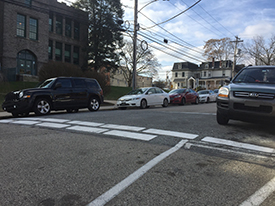Planner’s Portfolio: Traffic Calming
The 8th issue in the Planner’s Portfolio series focuses on Traffic Calming.
Traffic Calming is a transportation planning tool used to address high traffic volumes and speeding; reduce collision frequency and severity; reduce cut-through traffic; and increase access for all modes of transportation. The term traffic calming refers to three activities known as, “the three Es:” Education, Enforcement, and Engineering. Education refers to the dissemination of safety information to the public. Enforcement is police enforcement of speed limits and other traffic control devices. Engineering involves changes in roadway design that sustain safer driving.
 The goals of traffic calming are to encourage “self-policing” and make streets safe for a variety of users, including bicyclists and pedestrians. Traffic calming measures are not an appropriate solution for all roadways.
The goals of traffic calming are to encourage “self-policing” and make streets safe for a variety of users, including bicyclists and pedestrians. Traffic calming measures are not an appropriate solution for all roadways.
This issue of the Planner’s Portfolio series focuses on the most common and effective engineered traffic calming measures in Delaware County. Signs and pavement markings are a more affordable way to help reduce speeding, but they are not as effective as engineered roadway improvements.
Engineered traffic calming measures are appropriate on local residential streets, collector streets with predominantly residential land uses, and arterial roads within downtown districts or commercial areas with speeds of up to 40 miles per hour (Traffic Calming Handbook, PennDOT, 2012). Some such measures include curb extension/bulbout, on-street parking, traffic circle or roundabout, speed humps, brick paver crosswalks, and raised intersections.
This portfolio aims to provide municipal officials with an overview of engineered traffic calming measures and other speed-reduction techniques. This portfolio also outlines traffic calming best practices to mitigate emergency response delays.
For more information, check out the Traffic Calming issue or the entire Planner’s Portfolio series.
